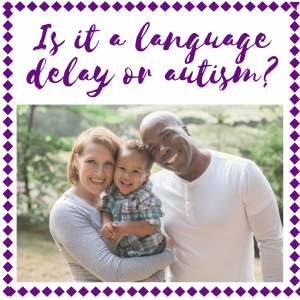
When your child is not talking and you are not sure why, it can be overwhelming to know where to start. Today you will learn about language milestones and also red flags for autism. It is important to know the facts, so that you can advocate and help your child. In general, there are things we can do as parents everyday to embed opportunities to work on communication and social skills in the home environment. I have created an easy to use free printable with these strategies, make sure to put your email in down below to get your copy today.
The Centers for Disease Control and Prevention (CDC) has a wealth of information about developmental milestones. Developmental milestones can give us a better idea of what our child should be doing at different times in their development. Milestones matter! If your child is not doing these things, it is important to share your concern with your pediatrician. Below I will highlight language based milestones. See the comprehensive list here.
At 2 months of age most babies:
- Begin to smile
- Look at their parent
- Coo
- Pay attention to faces
- Turn head towards sounds
At 4 months of age most babies:
- Smile spontaneously, especially at people
- Like to play with people
- Begin to babble
- Cry in different ways to show a variety of needs
- Recognize familiar people and items at a distance
At 6 months of age most babies:
- Like to play with others, especially familiar people
- Respond to sounds by making sounds
- Like taking turn with parent while making sounds
- Respond to own name
- Begin to string vowels together and say consonant sounds (m,b)
At 9 months of age most babies:
- Understand no
- Make a lot of different sounds like mama and baba
- Uses a finger to point at things
- Play peek-a-boo
At 12 months of age most babies:
- Are shy or nervous around strangers
- Repeat sounds or actions to get attention
- Use simple gestures like waving bye
- Try to say words you say
- Say things like mama, dada, uh oh
There are differences between a language delay and autism. Being informed is vital, so that you can get your child the help that they need as soon as possible! Read on to learn red flags for autism.
The following are RED FLAGS for autism. Autism Navigator lists 16 early signs of autism by 16 months. Learn more here.
- Hard to get your baby to look at you
- Rarely shares enjoyment with you
- Rarely shares their interests with you
- Rarely responds to their name
- Limited use of gestures such as showing and pointing
- Hard to look at you
- Little or no imitation of people or pretending
- Uses your hand as a tool
- More interested in objects than people
- Unusual ways of moving their body and hands
- Repeats unusual movements with objects
- Develops rituals and may get very upset over change
- Excessive interest in particular objects or activities
- Very focused on or attached to unusual objects
- Unusual reaction to sounds, sights or textures
- Strong interest in unusual sensory experiences
So what can you do if you are worried about your child’s development?
- Tell your child’s doctor if you notice any of
these signs of possible delay and ask for
a developmental screening. - Ask for a referral to a specialist.
- Schedule an appointment with someone who can evaluate and diagnose your child. A pediatric neurologist, child psychologist, child psychiatrist, or developmental pediatrician can evaluate and diagnose.
- Call your state early intervention program
to find out if your child can get services to help. - Work on communication skills in the home environment
Working on communication skills in the home environment is amazing for all children! Knowing how to easily embed activities that will allow for communication between parent and child is essential for development. The following are recommendations from the American Speech-Language-Hearing Association:
- Respond to your child. Look at them when they make noises.
- Talk to your child.
- Imitate the sounds they make.
- Teach your baby to imitate actions, like peek-a-boo, clapping, blowing kisses, and waving bye-bye. These routines help with turn taking.
- Talk about what you are doing throughout the day. Say things like “Mommy is drinking coffee”; “Daddy is eating pizza”; and “We are reading books.”
- Talk about where you go, what you do there, and who and what you see. Say things like, “We are going to the park today.” “We love to play on the swings at the park.” “The park is so fun!”
- Teach animal sounds, like “A sheep says baa.’”
- Read to your child every day.
- Talk to your child in the language you are most comfortable using.
References
American Speech-Language-Hearing Association. Language Milestones. Available from www.asha.org
Centers For Disease Control and Prevention. Developmental Milestones. Available from https://www.cdc.gov/ncbddd/actearly/milestones/index.html
Family Resources. (n.d.). Retrieved June 13, 2020, from https://autismnavigator.com/family-resources/

wow! Absolutely love your site. So many useful resources that I use probably on the daily. So informative and friendly. Thank you so much for all your hard work
Thanks so much for the note Andrea!!